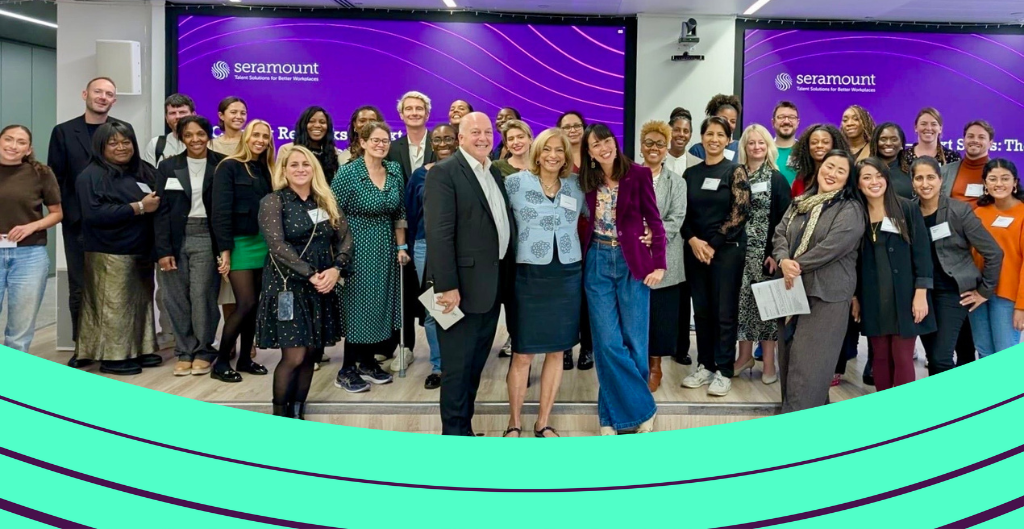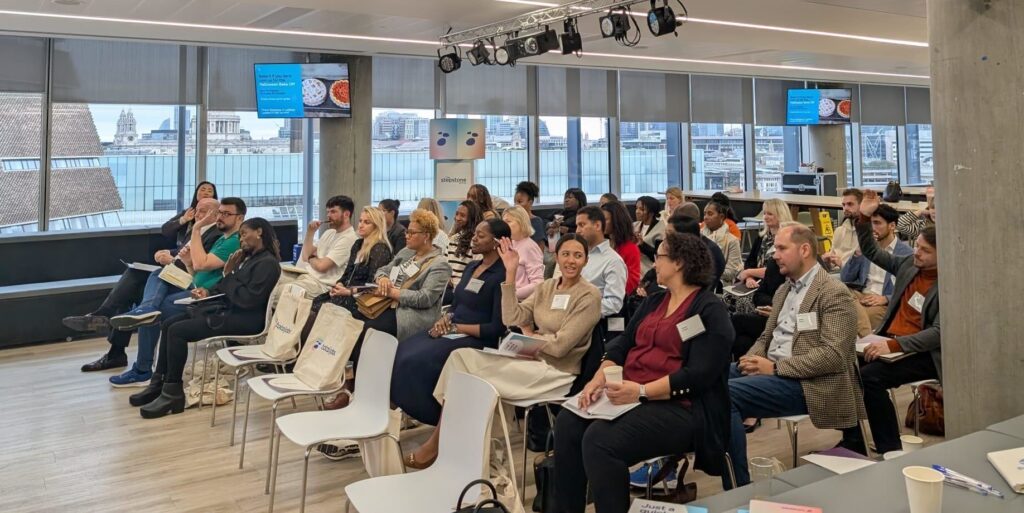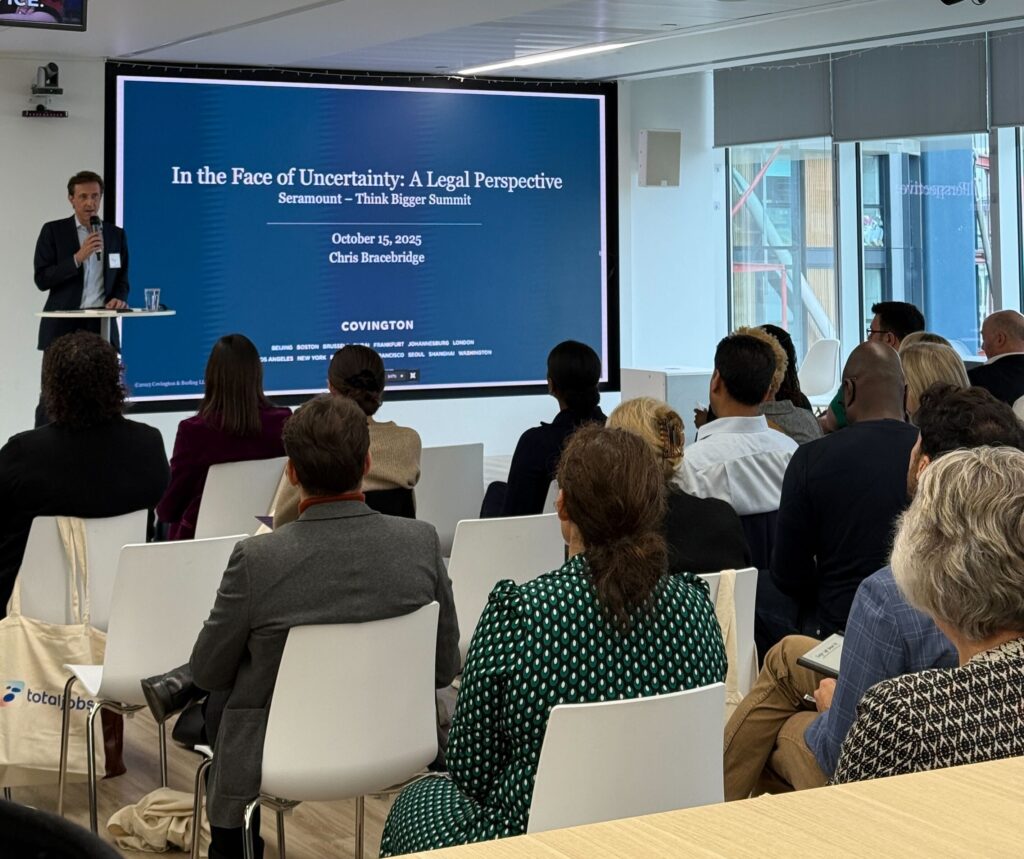Strategic Inclusion Under Pressure: Think Bigger Global Summit Highlights

Seramount’s Think Bigger Global Summit in London on 15 October 2025 convened CHROs, Inclusion leaders, and talent executives for a day of candid dialogue and strategy-sharing. Co-hosted in partnership with The StepStone Group, the event was designed to go beyond conversation – to spark momentum on “strategic inclusion” in a changing, high-pressure workplace. From the outset, summit organizers emphasized that today’s inclusion leaders face constant change and intensifying pressure, making spaces for reflection and innovation more critical than ever. Katie Mooney, Seramount Managing Director and summit emcee, set an optimistic tone: despite headwinds, this gathering would help attendees “look honestly at where we are now, consider what actions we can take in the present, and start imagining where we can go together”. With that, Mooney welcomed Seramount President Subha Barry to open the summit. Barry framed the global context bluntly: organizations everywhere are grappling with how to move from reactive to proactive on inclusion amid complex legal, cultural, and business environments.

Proactive Inclusion in a Complex World
Barry shared encouraging data, illustrating how inclusive hiring efforts are paying off. In a study of recruitment practices across the UK, Canada, and India, companies employing “tried-and-true” inclusion tactics – diverse candidate slates, diverse interview panels, mandatory bias training, and targeted sourcing – saw tangible results. In the UK, for example, 50% of new hires this year were women, up from 46% in 2023, with similar rises in Canada (55%, up from 51%) and modest results in India (37%, up from 36%). These upticks in women’s hiring underscore how inclusive talent strategies can drive measurable progress, reinforcing Barry’s point that inclusion can be a competitive advantage in every market. Barry also highlighted partnership as a catalyst for innovation: The StepStone Group, a global leader in digital recruitment and the summit’s host, exemplifies how embedding inclusion at a platform’s core helps connect talent to opportunity at scale. StepStone’s own Head of Diversity & Inclusion, Bianca Stringuini, echoed this vision of inclusion-fueled innovation in her welcome remarks, setting the stage for a day of learning and collaboration.
From Compliance to Influence: Aligning HR Leadership
The first session dug into a foundational question: how can Chief Diversity Officers (CDOs) and Chief Human Resources Officers (CHROs) join forces to amplify impact? James Cowling-Vega, shared insights from a new Seramount study based on interviews with over 100 CHROs. The research revealed that while most HR leaders support Inclusion in principle, truly integrating inclusion into business strategy requires moving beyond compliance-driven approaches to ones centered on influence and collaboration. Cowling-Vega noted that effective CDO-CHRO partnerships hinge on speaking the language of business outcomes. This theme of “shifting from explaining inclusion to executing with influence” resonated throughout the day. In fact, Seramount’s latest pulse survey found that only 1 in 5 CDOs feel they can effectively influence their C-suite on Inclusion, even as 90% say securing senior leadership buy-in is their top priority. Closing that gap is critical – without the ability to clearly link inclusion to business value, Inclusion efforts risk being sidelined or defunded in today’s environment. Cowling-Vega’s session underscored a clear call to action: HR and Inclusion leaders must continue to evolve from box-checking to business-aligned strategies, using data and influence to embed inclusion into executive agendas.
Moving with Trust in AI
A lively fireside chat on emerging technology examined the cutting-edge of inclusion practice: AI in HR. Nicola Weatherhead, StepStone Group’s VP of Talent Acquisition & People Operations, joined Subha Barry for a candid discussion on the promise and perils of artificial intelligence in people management. Weatherhead, a veteran tech industry people leader, and Barry emphasized moving forward with trust in AI – harnessing AI’s efficiencies in recruiting and talent management while maintaining human oversight and fairness. Attendees openly shared their experiences via live poll: many organizations are still in early exploratory stages of integrating AI in HR, and the top concerns on everyone’s mind are bias, transparency, and compliance with rapidly evolving laws. Weatherhead addressed these head-on, citing the forthcoming EU AI Act as a prime example of why HR leaders must stay proactive. Her guidance: treat AI as a tool to augment, not replace, human judgment, and build diverse teams to vet AI-driven decisions for unintended bias. She described StepStone’s approach to ethical AI – from rigorous bias testing in algorithms to cross-functional governance – as a model of balancing innovation with responsibility. The takeaway was clear: trust and innovation can co-exist. With the right guardrails, AI can help streamline hiring and expand talent pools, but earning employee trust means prioritizing ethics and transparency at every step.
Navigating Legal Headwinds in Inclusion
Legal and regulatory shifts have rocked the Inclusion landscape worldwide, a reality brought to life by Chris Bracebridge, Partner at Covington & Burling LLP and a leader on the firm’s global Inclusion Council. Bracebridge led a session on inclusion under pressure – how recent legal changes demand agile strategies from Inclusion and HR teams. He noted that in just the past 18 months, dramatic changes have altered what’s permissible or practicable in corporate Inclusion programs. From high-profile court decisions on affirmative action in the U.S., to new European regulations like the AI Act and pay transparency directives, to evolving UK compliance requirements – the rules of engagement for Inclusion are being rewritten in real time. Bracebridge broke down these complexities with practical clarity, reassuring leaders that inclusion and compliance are not mutually exclusive. For instance, he pointed out that even amid political pushback, companies can focus on inclusive practices that are universally beneficial, such as mentorship programs or diversity in recruitment, which carry low legal risk but high cultural impact. The key is to stay informed and creative: adjusting language, reframing programs, and doubling down on business relevance can help inclusion initiatives survive external challenges. Bracebridge’s bottom line: Inclusion leaders must become deft navigators of change, influencing stakeholders with both vision and vigilance. His insights – coming from a firm that’s been advising global companies through these storms since 2021 – provided a roadmap for turning legal “disruption into opportunity”, sparking ideas on how to future-proof inclusion efforts.
Macro Trends and Inclusion: An Economist’s View
After lunch, the summit zoomed out to a macro-economic lens, examining how broad labor market trends influence workplace inclusion. Julius Probst, Appcast’s European Labor Economist, presented a data-rich look at the British economy and job market in 2025. Probst, shared sobering statistics: the UK’s unemployment rate has crept up to 4.6%, and job vacancies have declined to their lowest since before the pandemic. After a long post-pandemic boom, Britain’s labor market is edging closer to a downturn, with hiring freezes and lower turnover as economic uncertainty rises. Yet within this challenging climate, there are silver linings for inclusion. Probst noted that a cooling labor market can push employers to focus on quality ofhire over quantity, presenting an opening to double down on inclusive recruitment – reaching talent that may have been overlooked in hyper-competitive Probst added perspective from on-the-ground in the UK: even as overall hiring slows, skills shortages persist in sectors from technology to care services, meaning companies that cast wider nets and invest in upskilling diverse talent will weather the storm better. This economist’s view reinforced a theme from earlier in the day – inclusion as innovation under pressure. When macro headwinds blow, inclusive practices like reskilling, internal mobility, and flexible work can become engines of resilience. The session vividly connected the dots between global trends and daily inclusion work, reminding leaders that Inclusion strategy must flex with economic realities.

Collaborative Solutions: Evolving ERGs and Beyond
Caroline Waters, OBE – a veteran HR executive and Deputy Chair of the UK’s Equality and Human Rights Commission – led an eye-opening breakout session on global demographic shifts and what they mean for inclusion. Co-facilitated by Angela Lacerna, an Associate Director of Partner Development at Seramount, the session challenged participants to think bigger about where talent and consumers will come from in the future.
Waters highlighted several striking facts as signals of a massive demographic transformation unfolding worldwide:
- English speakers on the rise: China is poised to become the largest English-speaking nation in the world.
- Talent pool scale: The top 25% highest-IQ individuals in China outnumber the entire population of North America (and India’s top 28% does as well).
- Workforce surplus: Even if every current U.S. job were transferred to China or India, those countries would still have a huge surplus of workers to spare.
- Skyrocketing birth rates: In the time it takes to read this sentence, dozens of babies are born around the globe – about 38 in the United States, 92 in China, and 241 in India. As Waters put it, “the speed of global diversification is almost too fast to grasp.”
- Shifting majorities: In Birmingham, UK, the balance of demographics flipped within a decade. The city went from roughly 58% White and 42% Black in 2011 to about 49% White and 51% Black in 2021 – a complete reversal of majority and minority representation in just ten years.
- Youth resurgence: In the UK, church attendance among young adults has quadrupled, from only 4% in 2018 to 16% today. This unexpected surge in youth participation is another example of how quickly social trends can turn.
Each of these data points, Waters explained, is more than just a statistic – it’s a wake-up call. Together, they paint a picture of a world where diversity is the new normal on a global scale. Populations and workforces in Asia are booming, educational and linguistic advantages are no longer confined to Western nations, and even local communities are seeing dramatic shifts in composition and behavior. For inclusion strategists, the implication is clear: we must anticipate and embrace a far more diverse future. Inclusion efforts can’t rely on old assumptions about where talent comes from or what “majority” means in any given context. Instead, leaders should prepare for a reality in which the so-called ‘minority’ groups may become majorities (and vice versa), and cultural patterns may shift unexpectedly.
ERGs: From Passion to Strategic Impact
Katie Oertli Mooney, Managing Director at Seramount, shared that even as some organizations pull back on formal DEI programs, employee resource groups (ERGs) remain resilient and continue to evolve. She introduced a new ERG maturity model with two dimensions – operational and impact – urging companies to move beyond grassroots passion to a structured infrastructure with leadership alignment from the top down. On the impact side, Mooney challenged leaders to think past what ERGs do (hosting events or programs) and focus on what they enable for the business and culture. The message was clear: leading organizations treat ERGs not as extracurricular networks, but as strategic partners in driving inclusion and innovation.
Mooney illustrated how high-functioning ERGs serve as pipelines for relationship-building and talent development. ERG leaders and members gain vital experience – from cross-functional collaboration and strategic planning to mentoring others – that hones their business acumen and inclusive leadership skills. These experiences build executive presence and influence among diverse talent, empowering employees to drive cultural fluency across the organization. In short, ERGs can be incubators of future leaders, translating grassroots energy into tangible business capabilities.
Spotlight Stories of Resilience and Innovation
As the summit’s final segment, two industry leaders delivered inspiring spotlight stories illustrating how they are driving inclusion forward in challenging times. Sharlene John, Head of Inclusion, Recruitment and Onboarding at Selfridges, spoke about cultivating talent and culture in the luxury retail sector. John described how Selfridges partners with the King’s Trust to promote internal talent development, creating avenues for underrepresented employees to advance and lead with continued support at the close of the program.
Next, Annika Allen, Head of Inclusion at All3Media, offered a candid look at building inclusion in media and entertainment – an industry known for creative dynamism and, often, systemic inequities. At the summit, Allen spoke passionately about the link between employee well-being and inclusion. In an environment prone to burnout and high stress, All3Media has made employee mental health a pillar of its Inclusion strategy – from inclusive storytelling workshops that give employees a voice, to equitable parental leave and flexible work arrangements. Allen’s core message: creativity and inclusion thrive together when people feel safe, valued, and cared for as whole individuals.
Think Bigger, Act Smarter: What’s Next
After a full day of insights and exchange, the Think Bigger Summit concluded with a unifying call to action. In closing remarks, Subha Barry observed that through every panel, spotlight, and hallway conversation, one theme came up again and again: “This work lives or dies by our ability to influence.” Influence – built on trust, backed by data, and aligned to business priorities – is the linchpin for turning inclusive ideas into sustained action. Barry challenged every leader in attendance to carry the day’s learnings back to their organizations and “engineer influence” for the changes that matter. Some key messages emerged from the summit’s conversations:
- Moving with trust in AI: Leverage AI-driven tools in HR and recruiting, but do so ethically and transparently, addressing biases and ensuring human oversight at each step.
- Inclusion as innovation under pressure: Treat inclusion as a source of innovation and resilience, especially in turbulent times. When under pressure – whether from legal, economic, or social forces – doubling down on Inclusion can reveal new solutions and growth opportunities.
- Shifting from compliance to influence: Evolve from check-the-box diversity compliance toward true influence in the C-suite. Build the business case with data and storytelling, and speak to what drives your particular organization. Inclusion isn’t a “nice-to-have” – it’s a strategic imperative, and it demands the same rigor and buy-in as any core business initiative.
- Evolving ERG maturity and impact: Invest in the maturity of Employee Resource Groups so they become strategic partners in talent development and innovation. Provide ERGs with executive sponsorship, clear objectives, and metrics to showcase impact, moving them from affinity communities to engines of business insight and leadership development.
Looking ahead, Seramount is committed to keeping this momentum going. Seramount’s Global Inclusion Index remains open for organizations to benchmark not just what they say, but what they do, across 29 countries. And the upcoming Global Member Conference will reunite this community to continue the conversation, dive deeper into new research, and turn ideas into action. These efforts are part of Seramount’s broader 2026 thought leadership agenda, all aimed at one goal: helping inclusion leaders think bigger and act smarter to meet the demands of this changing workplace.
Together, we are turning aspiration into action, and ensuring that inclusion not only keeps pace with change, but drives the innovative workplaces of tomorrow.



